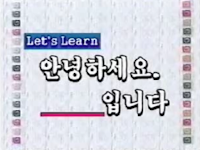About - how to tell someone what you do for a living
 The expression "입니다" means "to be" in English. When you introduce yourself to others, you say "저는 (누구)입니다." And "저는 (어느 나라) 사람입니다" is said when you say where you are from. The basic form is "(저는) 명사 (Noun) 입니다." "저는" can be omitted, and 명사 (noun) can be your name or nationality or profession etc. Let's see the following sentences:
The expression "입니다" means "to be" in English. When you introduce yourself to others, you say "저는 (누구)입니다." And "저는 (어느 나라) 사람입니다" is said when you say where you are from. The basic form is "(저는) 명사 (Noun) 입니다." "저는" can be omitted, and 명사 (noun) can be your name or nationality or profession etc. Let's see the following sentences:저는 김민욱입니다. ------ I am Kim Min-Wook. (Name)
저는 중국 사람입니다. --- I am a Chinese. (Nationality)
저는 학생입니다. --------- I am a student. (profession)
This lession explains how you can ask what they do for a living and tell them your profession using the expressions "입니까?/입니다." The expression "입니까?" is question form of "입니다." For example, if you want to know someone is a student, you can ask him or her:
(당신은) 학생 입니까? --- Are you a student?
And then, the person will answer:
네, (저는) 학생입니다. --------- Yes, I am.
아니오, (저는) 회사원입니다. --- No, I am an office worker.
Here "네" or "예 (ye)" means yes, and "아니오" means no in English. In general, "ㅂ니까?" is question form of "ㅂ니다." For example,
어느 나라에서 왔습니까? --- 미국에서 왔습니다.
학생입니까? ----------------- 학생입니다.
Expressions and Practice
학생입니까? Haksang-imnikka?
네, 학생입니다. Ne, haksang-imnida.
아니오, 회사원입니다. Anio, hoesawon-imnida.
Let's ask your friends about their profession in Korean using the following words:
간호사 (ganhosa) ---------- nurse
과학자 (gwahakja) -------- scientist
기자 (gija) ------------------ journalist
선생님 (seonsangnim) --- teacher
의사 (uisa) ----------------- doctor
학생 (haksang) ----------- student
회사원 (hoesawon) ------ office worker
More resources for learning Korean:
infocobuild Learning Korean




